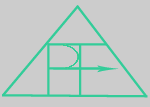Can we rediscover calcium and magnesium?
The intention of the works on painting is not to portray reality; rather, very specific "findings" are frequently brought together in order to create a new poetic reality which is perhaps in the tradition of a metaphysic painting. Thus, the paintings are dominated by an almost "form-like reality" and develop imaginary picture worlds.
Figures, objects and images signalise impressive concrete statements in form and colour. The themes frequently document absurd, inexplicable poetic motifs of an unfathomable other world. A quiet humour, combined with an unassuming eroticism, is typical as basic elixir. A subtle interpretation of the spectral colour teachings within several motifs as well as a concrete expressive form and colour language are an urgent matter. Thus for example, the title "The discovery of calcium and magnesium" of the card catalogue refers to ancient Roman medicine glasses - so-called balsam vessels - which date back to approx. 100 A.D. and which are to be found in the Roman-Germanic Museum in Cologne. Two antique glass creations that are particularly expressive in their filigree form language were baptised "Calcium and Magnesium" by the artist and frequently integrated into the paintings as key symbols for the underlying minerals. After all, it is a known fact that nothing functions without calcium and magnesium!
The protagonist in this picture is a famous tennis player with a "fictitious" partner. Both have taken their places on the post-modern chairs designed by Holger Scheel around 1983 and are celebrating the discovery itself without strings in the racquets. In further works, significant contemporary interior with chrome and glass and typical design accompanies the scenery of the "players".
Similarly to the secretive aura of the balsamic vessels, the attentive observer finds additional "items" in the pictures: a jade bowl from the Ming dynasty, the Dame Jade as "Doctor Lady", as a symbol and allusion to the "Naked Maja" of Francisco Goya (1803). The aquilegia flower, a porcelain ballerina as well as a harlequin with starry bowl or, in the painting "In the secretariat of wishes" a female symbol of the Indus culture (3000 BC) embodies the permanently topical erotic motif. The ultra-marine-coloured vases without flowers are lit up by pale moonlight - in the light of the darkness. The tennis racquets whose strings are transposed in some themes as so-called "black holes" find an equivalent in the picture "Plus Minus" to the performances of wind propellers through the so-called neutral colours black and white. The picture ´Green Aello in Hoppenbruch' depicts the encounter of a harpy - a goddess of Greek mythology - with Germany's first wind power plant. Harpies - who were birdlike female figure beings - were responsible for the blowing of the winds. This picture does not aim at enlightening the viewer about the question whether Aello who was answerable for the moderate winds intends to stop the wind turbine or to get it going. The wind power plant causes an injury.
With the dumbbell motifs, the power dispensers are sawn up whereby, in the painting "Verdigris", the melted-away time lays itself over the metal. In the more recent works, the colours become brighter and replace the dark colour moods of earlier works which can also be seen as night pictures (moonlight). The rather sober illustration of consumer articles and food, which are presented on glass dishes, is to be regarded as a further development of the still life.
With the figure motifs, the clothing of the protagonists plays a significant role as a dramatic statement. These are differing forms of modern sporting clothing or examples from the history of costumes - like the "Zatteln" in the picture "Carpe diem II" - which are borrowed from the Burgundy fashion of the 13th Century. Or the mi-parti (French - half shared) in the painting "Lamento Orange" on the "Player" is accentuated using the colours yellow and violet from the group of spectral colours. The item of furniture on which the beauty is down on one knee, is a parody of the famous chair of G. Thomas Rietveld, a so-called "Re-Design" of the Alchemia Group (Italy 1978).
In his paintings, the artist also transforms realities and happenings into unexpected sequences of events through corresponding poetic interweaving. Seemingly incompatible elements are linked, creating a new reality, coupled with a certain imagery.
One example is the painting "Memory of Jeff and Michael on Madagascar", from the year 2010, which shows the pop icon Michael Jackson in the familiar body pose of the sculpture entitled "Michael Jackson and Bubbles" (1988) by Jeff Koons. Here, however, M.J. is sitting in a tropical landscape on Madagascar and is holding not a monkey (as with Koons) but another primate – a ring-tailed lemur – on his right knee. Jackson is wearing a Russian uniform. This is the clothing that he wore when disembarking from the aeroplane during a visit to the Russian metropolis.
The painting "Old Michael in bronze", also from 2010, shows M. J. holding an antique frame – as a much older man, which, as we know, he did not become – and wearing a historic military uniform featuring gold coins in the chest area. He is painted in bronze. Here, therefore, an interpretation using a well-known bronze bust showing Jackson in younger years. Both paintings constitute an ironic appreciation of Michael Jackson.
In recent years, the painter has often taken an original, ironic and critical stance with regard to political events. In one example from 2012, a rather spectacular shoe purchase by Asma – wife of the Syrian dictator, Assad – led artist Peter-Arnold Fritze to provocatively juxtapose the spiked crystal-toecap stilettos with two sex toys (dildos) and a dried thistle. (See also catalogue, page 59, Homepage register 102).
Other paintings have also been inspired by recent events, such as
The works always document binding statements in form and colour. Nevertheless, they are not only committed to a craftsmen's tradition, but rather new questions are asked concerning the medium of painting.
